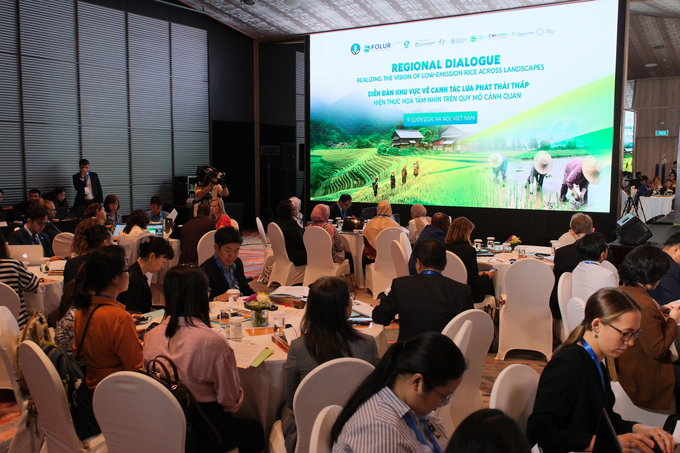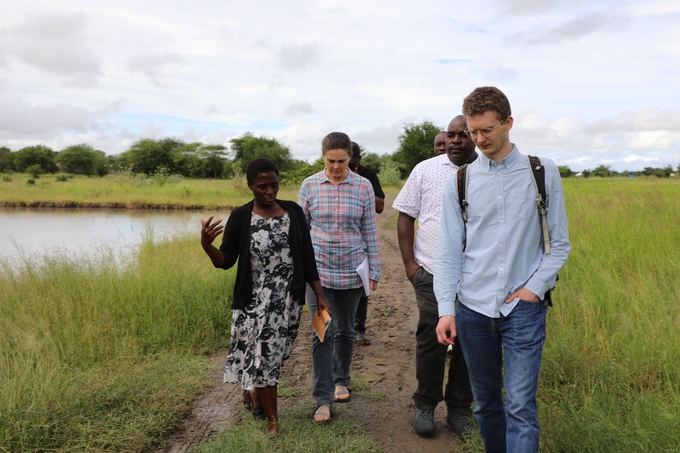May 21, 2025 | 04:09 GMT +7
May 21, 2025 | 04:09 GMT +7
Hotline: 0913.378.918
May 21, 2025 | 04:09 GMT +7
Hotline: 0913.378.918

Regional forum ‘Realizing the vision of low-emission rice across landscapes’ on September 9. Photo: Quynh Chi.
Rice production is a critical component of Chad’s agricultural landscape, particularly in the Tandjilé Province, where integrated production systems combining rice and secondary crops are being implemented using an agroecological approach.
This approach aims to address the dual challenges of enhancing food security and reducing greenhouse gas (GHG) emissions, which are significant concerns given the country's substantial agricultural potential and environmental vulnerability.
Chad, with a population of approximately 18 million people and a vast surface area of 1,284,000 km², is endowed with considerable agricultural resources. The country has 39 million hectares of arable land, of which 5.6 million hectares are irrigable, although only 2.2 million hectares are cultivated annually. Chad also has abundant renewable water resources, including 45 km³ of groundwater and 20 km³ from underground aquifers.
These factors position Chad as a nation with significant potential for agricultural production and rice in particular, yet challenges in sustainable resource management and GHG emissions persist.
The integrated production of rice and secondary crops in the Tandjilé Province, specifically targeting a population of 926,792 individuals, including 485,058 women, aims to increase rice and cash crop production in the region over a four-year period (2025-2029).

Chad applies an agroecological approach to rice and secondary crop production. Photo: ADB.
The project focuses on three main outcomes: strengthening institutional capacity and implementing legal reforms, adopting agroecological practices on 5,900 hectares, and engaging value chain actors and financial institutions. The overarching goals are to conserve and sustainably use biodiversity, implement sustainable land management and restoration practices, and reduce GHG emissions.
The project is set to directly benefit 150,000 individuals, with a focus on producer organizations, umbrella organizations, women, youth, women’s cooperatives, and women-headed households. This targeted approach seeks to empower marginalized groups, particularly women, by enhancing their participation in sustainable agricultural practices and value chains.
Innovative aspects of the project include water control through drip irrigation systems, the use of renewable energy sources such as photovoltaics, and the implementation of agroecological practices to manage soil fertility. By conserving natural habitats and promoting biological pest control, the project aims to reduce pesticide use and integrate agropastoral practices that enhance soil fertility.
These strategies are designed to not only increase agricultural productivity but also to minimize the environmental impact of farming, thereby contributing to a reduction in GHG emissions and promoting sustainable land use practices.
In Tanzania, the project aims to promote integrated land and water management, restoration, and sustainable rice value chains to prevent deforestation and land degradation in priority landscapes. By enhancing agricultural practices and governance structures, the initiative seeks to balance productivity with environmental conservation.
Tanzania faces significant challenges in maintaining ecosystem health due to habitat and ecosystem degradation. Notably, wetland areas have reduced drastically from 4.6% in 1996 to 0.9% in 2016, representing an 80% loss. Concurrently, agriculture and grassland areas have expanded by 11.3% and 13.3%, respectively. The expansion of rice cultivation is a contributing factor, driven by low productivity and a growing population.
Currently, rice productivity is approximately 1.2 to 2 tons per hectare, far below the potential yield of 6-8 tons per hectare. Key issues include inefficient water use, outdated seed varieties, and poor agronomic practices from seed selection to post-harvest handling. These factors contribute to high levels of greenhouse gas emissions. Advanced techniques such as alternate wetting and drying (AWD) and the system of rice intensification (SRI) are rarely practiced due to a lack of knowledge, awareness, infrastructure, and funding.

IRRI project to build a climate-smarter Tanzania. Photo: IRRI.
Despite these challenges, there are significant opportunities to improve rice production sustainably in Tanzania. The SRI has gained strong advocacy and presents an opportunity for scaling up. Additionally, the formulation of a National Agroecology Strategy and the development of a framework by the Tanzanian Ministry of Agriculture for carbon emission accounting in paddy production are promising steps towards sustainable intensification.
Furthermore, the ongoing review of the National Rice Development Strategy II (2019-2030) places emphasis on mitigation measures, providing a policy framework to support sustainable rice production.
Therefore, the objectives of Tanzania’s rice project includes addressing the barrier of poor institutional coordination and integrated planning systems for land and water use management. By fostering integrated landscape management (ILM) systems, the project aims to streamline efforts across various stakeholders, ensuring that land and water resources are managed sustainably and cohesively.
Besides, the initiative emphasizes the development of sustainable and socially inclusive value and supply chains for the rice production sector. It includes building supportive governance, finance, and market approaches that can drive the adoption of sustainable practices in rice production, thereby enhancing productivity while minimizing environmental impact.
Thirdly, the project aims at addressing habitat degradation, this objective focuses on the implementation of concrete landscape restoration activities and the creation of enabling conditions for effective conservation. In doing so, it promotes inclusive and participatory integrated land and water use management plans, which are essential for the improved management and restoration of natural ecosystems.
By addressing the barriers to sustainable rice production and leveraging these opportunities, the project aims to transform rice value chains in Tanzania, contributing to the broader goals of environmental conservation and climate change mitigation.

(VAN) Attempts to bring down the price of the Japanese staple have had little effect amid a cost-of-living crisis.

(VAN) Fourth most important food crop in peril as Latin America and Caribbean suffer from slow-onset climate disaster.

(VAN) Shifting market dynamics and the noise around new legislation has propelled Trouw Nutrition’s research around early life nutrition in poultry. Today, it continues to be a key area of research.

(VAN) India is concerned about its food security and the livelihoods of its farmers if more US food imports are allowed.

(VAN) FAO's Director-General emphasises the need to work together to transform agrifood systems.

(VAN) Europe is facing its worst outbreak of foot-and-mouth since the start of the century.

(VAN) The central authorities, in early April, released a 10-year plan for rural vitalization.